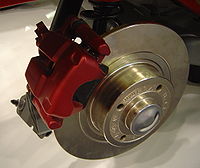
Photo from wikipedia
The viscoelastic-plastic dynamic properties of rail pads were are not adequately accounted for in the traditional vehicle–track coupled dynamic model. To investigate the influence of the viscoelastic-plastic dynamic properties of… Click to show full abstract
The viscoelastic-plastic dynamic properties of rail pads were are not adequately accounted for in the traditional vehicle–track coupled dynamic model. To investigate the influence of the viscoelastic-plastic dynamic properties of rail pads on the high-speed vehicle–track coupled vibrations, we obtained the viscoelastic-plastic dynamic properties of rail pads first by a series of laboratory tests, after which we described these properties theoretically by a modified Fractional Derivative Zener (FDZ) model and a traditional Berg friction model. A modified vertical vehicle–slab track coupled dynamic model was established by introduction of the modified FDZ and traditional Berg models for rail pads to investigate the influence of the viscoelastic-plastic dynamic properties of the rail pads on the high-speed vehicle–slab track coupled vibration responses under various preloads and temperatures. The FDZ and Berg models for rail pads improved the calculation accuracy of the high-speed vehicle–slab track coupled vibration responses, compared with the traditional KV model for rail pads, especially in the dominant high frequency range. The dynamic plastic properties of the rail pads effectively suppressed the high-frequency wheel-rail forces and yet increased the high-frequency vibration responses of the track substructures under the rail. Low temperatures and increased preloads on rail pads had a similar effect on the vehicle–track coupled vibrations. Increasing the preload on rail pads or decreasing the temperature increased the wheel-rail random excitation energy and its dominant frequencies, increased the vibration responses of the wheel-set and the track substructure under the rail, and decreased the vibrations of the rail at nearly all frequencies. Highlights The dynamic viscoelasticity and plasticity of rail pad under preloads and temperatures were tested. A modified FDZ model for the dynamic viscoelastic properties of rail pads was proposed. The dynamic plastic properties of rail pads can decrease the high-frequency wheel-rail forces. The dynamic plastic properties of rail pads can increase the high-frequency vibration under the rail. Low temperatures and increased preloads on rail pads had a similar effect on vehicle/track vibration.
Journal Title: Vehicle System Dynamics
Year Published: 2019
Link to full text (if available)
Share on Social Media: Sign Up to like & get
recommendations!